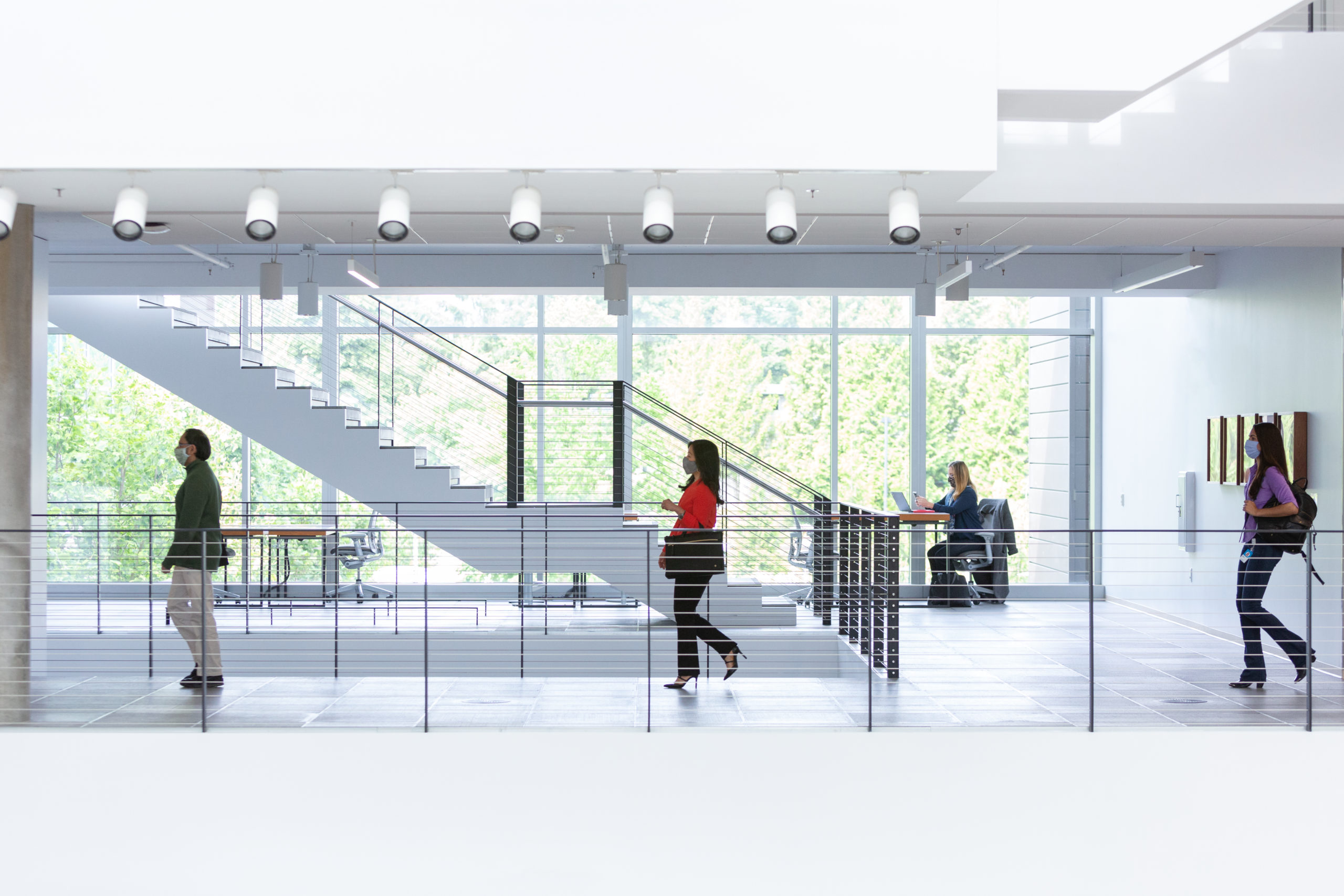By Nick Hedderman, Director of the Modern Work and Security Business Group at Microsoft UK
The COVID-19 pandemic has been a watershed moment for the digital transformation of businesses.
Satya Nadella, Microsoft’s Chief Executive, has spoken about how the world has gone through ”two years’ worth of digital transformation in two months”.
We’ve seen that in the UK, where companies who were in the early stages of rolling out digital transformation plans have dramatically increased the pace of these changes in order to give staff the tools and systems they need to be able to work and collaborate remotely.
In June, the NHS deployed M365 to as many as 1.2 million staff across NHS organisations, including Trusts, CCGs, and health Informatics Services, creating a truly joined-up national health service.
Schools, colleges and universities across the UK have embraced Microsoft Teams to ensure that teachers and students can stay in touch and share work.
Nationwide, another Microsoft customer, has seen record use of Microsoft Teams as employees work from home. Around 2.5 million video calls were made by Nationwide employees in June alone, up nearly 3,000% on February. Screen shares rose 750% as 12,000 colleagues worked from home and took part in daily meetings.

The pandemic has created turmoil and uncertainty for companies across the world. At Microsoft, we’ve spent the past few months learning from our customers and studying how they are adapting to the challenges of today. What’s clear is that we see the world – and the UK – going through three distinct phases.
First, which is largely in the past, was simply responding to the immediate impact of COVID-19.
The second, which is very much on everyone’s minds today is recovery and how organisations get back on track and start to function in the “new normal” – whatever that may look like.
Finally, the third phase is how organisations ultimately reimagine the very nature of their operations through the innovations born of necessity during the previous two phases.
Now is the time to recover and reimagine to ultimately create competitive advantage for years to come.
Let’s take a closer look at these three phases.
RESPOND
Organisations of all sizes have been reliant on technology in the short-term to operate, maintain continuity, remain open and adapt during exceptionally difficult circumstances.
From a Microsoft perspective, we’ve seen this, in the usage of our products:
- In the past quarter, users of Microsoft Teams generated more than five billion meeting minutes in a single day
- People have been turning on video in Teams meetings two times more than before the pandemic, as employees working from home looked for new ways to drive human connection
- The use of Windows Virtual Desktop tripled in the first quarter of 2020 as organisations deployed virtual desktops and apps on Azure to enable secure remote work
- Windows 10 now has more than 1 billion monthly active devices, up 30% year-over-year
- Power Apps monthly active users increased 170% year-on-year, with strong uptake of the crisis management response templates.
It’s fair to say there has been a massive shift to remote working.
However, dig a little deeper and what we saw was many organisations simply looking to replicate what was previously done in the office in a virtual environment. The critical question is whether this is the optimal way for organisations to operate in the “new normal”?
Companies and their staff need to take this opportunity to become truly digital-first. Holding Teams calls with colleagues is a good first step to becoming more productive and collaborative, but it’s just the tip of the iceberg. There are many tools, such as OneNote and OneDrive for sharing notes and files, Dynamics to put you in control of your business, and PowerApps for creating low-code and no-code solutions to make your working life easier.
Now that you’ve taken your first step towards being a digital workforce, it’s important not to stop now.
RECOVER
The pandemic has sparked a cultural shift in the expectations of workers. In a recent trend report published by Microsoft:
- 83% of UK managers surveyed expect to have more flexible work from home policies post-pandemic.
- 72% of UK employees and managers report a desire to continue working from home at least part-time
- Yet, 62% felt less connected to their team working from home.
This is important. Among all the hype around remote working, there is still a clear need for human interaction. Not everything can be done virtually and, indeed, not everyone can work remotely.
As we recover and reimagine, we believe the future of work isn’t simply replicating the old way in a digital form. We believe organisations that embrace a true hybrid work strategy – reinventing the way work is done digitally, while respecting and leveraging the great things about the way we used to work – will ultimately create a competitive advantage for themselves for many years to come.
As organisations think about their hybrid work strategy, they will need to consider how to adapt for their people, places of work and processes.
Read more:
Blog: How a hybrid workplace can drive innovation and growth
Here are just a few questions and challenges facing organisations today:
People:
- How do we recruit, onboard and manage great talent remotely?
- How do we teach people the right skills for their ever changing roles?
- How do we equip employees to securely work from anywhere?
Place:
- How do we return to the workplace safely and securely, and manage ongoing risk?
- How do we set up the office environment so that digital and physical come together, making it seamless for all?
- How do we better connect workers on the frontline with those in back office or head office locations?
Process:
- How do we use technology to make processes more efficient, open and collaborative?
- How can manual or physical processes be replicated in a digital form?
We have the tools to enable people to work remotely, but that’s only half of the solution that staff need to adopt for the “new world of work”. The other half is an inclusive mindset – making sure that employees feel part of their team, wherever they choose to work from.
It’s important that everyone has the same, positive experience of a meeting, regardless of whether they are physically present in the office or joining remotely via Teams. This may require a re-assessment of office meeting rooms and investment in digital tools. Offices may even need to be renovated to put more emphasis on large-screen monitors and a Teams Room System to ensure everyone, both physical and virtual, feel included.
This hardware could also be placed in areas where people in the office take breaks, allowing them to share a virtual coffee with friends working from home. As I have said, it’s crucial for personal wellbeing that companies maintain a team dynamic even when people are not together. Encouraging colleagues to relax and chat about non-work-related topics via Teams as part of their day is crucial.
We’ve looked at the office environment and how it might need to change, but what about people working from home? Do they need to change their home office, too?

Traditionally, companies have tried to entice people to work for them by offering perks such as company cars. If you work from home most of the time, do you still need a new car? You’re more likely to need a powerful and reliable laptop, a high-spec phone, a powerful webcam, a comfortable chair and the right desk, and high-speed broadband. These will become the differentiator that will sway a person to work for one company over another.
There are also environmental considerations, too. According to a survey last year, nearly 40% of millennials have chosen a job because of company sustainability. It’s an important factor for many employees. There will be people who are happy working from home, re-using their own, ceramic mugs and not taking up space and using energy in a city office block, because it’s reducing their carbon footprint.
There are many things to consider and there is no “one size fits all” approach to the new world of work. Every organisation will have their own, unique situation. Ultimately, for the hybrid workplace transformation to be a success, companies must focus on three things:
- Leadership: devising a strategy that enables people to work effectively regardless of location, that enables collaboration, creativity and maintains a sense of cohesion and shared purpose will be key. This has to come from the top, from the CEO’s office. It shouldn’t be something driven by the IT department or HR. Of course, the role of these departments is critical to success, but ultimate responsibility needs to be borne by the most senior leaders in the organisation.
- Culture: people are the heartbeat of any business. An effective culture gives people not only the means to be productive but also the power to innovate, adapt and progress. It’s imperative that leaders ensure their people have the right skills, and create an environment where everyone feels included to bring their best self. Creating the right culture is something that Microsoft has worked on for many years – and continues to do so. Creating a diverse and inclusive workplace is a goal without an end. You should always be looking to do more. At Microsoft, we have employee resource groups that support staff who identify as LGBTQ+, BAME, female and have accessibility needs. These groups hold regular events to help every person at Microsoft learn about what they can do to create a truly inclusive working environment.
- Technology: having the right technology platform in place to facilitate a strong culture in the age of the hybrid workplace is key. For example, Microsoft Teams helps organisations give people a single tool to chat, call, meet and collaborate. Most recently, we’ve introduced a new feature called Teams Together that uses an AI segmentation model to place participants together in a shared virtual space as if they’re all in the same room together, making virtual interactions more natural, more engaging and, ultimately, more human. Not every organisation can provide corporate devices for remote work, but you can enable access to company data on personally owned devices using Microsoft Intune app protection policies combined with Azure AD Conditional Access. This way your organisation still has the right level of control over information accessed. If you need more control around the environment your users are accessing corporate resources from, then Windows Virtual Desktop hosted in Microsoft Azure can help. If you need to get new devices for your employees to work remotely, Windows 10 and Surface devices have security features built in.
Leaders who fortify their vision for all of these areas will find it easier to transform their business, recover faster and emerge stronger than those that do not.
RE-IMAGINE
What really excites me is the potential for organisations to reimagine their entire business strategies in the long term, especially as the UK nears the end of the transition phase of Brexit. As the UK ventures onto the world stage by itself, we need to ensure our organisations are match fit and ready.
I think the very genetic make-up of our organisations will change dramatically. Employee expectations of ways of working have changed for the long run. We no longer expect to be in the office from 9am to 5pm, five days a week.
We have a different view on what work-life balance means to us – and with this brings new opportunities. Organisations can reimagine the role of the workplace. I expect offices to change significantly. They will no longer be a place for traditional desk-based working but a drop-in place for collaboration and connection – from in-person meetings with customers, creative workshops and team-building opportunities.

Company footprints will change, with moves away from major city centres or downsizing at the very least, to more agile use of temporary spaces such as remote working environments and hotels.
But there is a broader opportunity beyond the make-up of the workplace itself.
At Microsoft we think about four elements of digital transformation – empowering employees, optimising operations, transforming products and engaging customers.
Much of the transformation in recent months has been focused on empowering employees. But businesses now have an opportunity to go a step further.
The shift to cloud computing that we’ve seen recently has created a platform for deep transformation and reimagining of business processes. A platform has been created that will be a springboard for future growth.
Let me give you some examples:
- Boosting productivity with AI: AI has the ability to augment employees, helping them make better decisions and focus on higher-value tasks, whilst also boosting inclusivity and sparking creativity.
- Harnessing organisational knowledge: while firms sit on vast amounts of knowledge, accessing it and using it at the right time to make smart decisions is hard. By utilising cloud technologies, firms can gather insights and organise content to identify trends and determine the best course of action in ways that are simply not possible via traditional means. Organisations can use data to see which collaboration tools are most popular and focus on updating these. They can see who is working from home, perhaps because those people need to take children to school, and tailor team meetings accordingly, at a time that suits everyone. Data is important to inform actions in any part of a business, and it’s critical to ensuring your employees are happy, productive and collaborative.
- Protecting data, people and organisations: in a complex security landscape, organisations need an integrated and take an intelligent approach to security, powered by the cloud and AI. Customer trust is everything and so ensuring employees have access to the information they need, wherever they are, whilst maintaining security, privacy and regulatory compliance is vital.
The path ahead is full of many uncertainties. We need to get ahead and reimagine the organisation of tomorrow to build resilience and power the UK economic recovery.
As such, organisations need to prioritise. They need to embrace the hybrid working strategy, thinking about how it will impact their people, place of work and processes that surround them. Leadership, culture and technology are at the heart of this transformation.
Organisations have the opportunity to reimagine the very essence of who they are and how they work. Those that do, will ultimately create a competitive advantage in the years to come.







